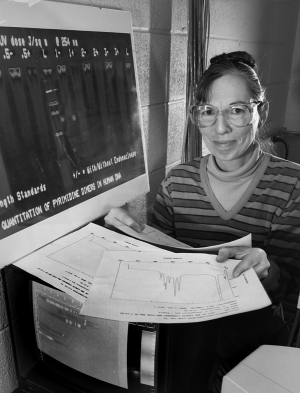To measure DNA damage and repair, Betsy used an enzymatic workup and gel electrophoresis, using fluorescence to visualize the DNA profile on the gel. Betsy got the data by taking a Polaroid picture of the gels, photocopying the DNA profiles, cutting the profile segments, and weighing each one. John remembers coming past the technician at the photocopy machine on day, saying, “We have to do better than this.”
The result was IMAGESystem, an electronic imaging system that accurately measures the distribution of DNA in an electrophoretic gel. It was the first gel-imaging system to use a digital camera to record fluorescence. It made it possible to measure the DNA damage caused by UV radiation easily. It also enabled measurement of the efficiencies by which different UV wavelengths cause DNA damage.
In IMAGESystem, enzymology, electrophoresis, optical imaging, analytical calculations, and computers all came together. The imaging system won for John’s group at Brookhaven a 1987 R&D 100 Award.
To measure DNA damage and repair, Betsy used an enzymatic workup and gel electrophoresis, using fluorescence to visualize the DNA profile on the gel.
Betsy got the data by taking a Polaroid picture of the gels, photocopying the DNA profiles, cutting the profile segments, and weighing each one. John remembers coming past the technician at the photocopy machine one day, saying, “We have to do better than this.”
The result was IMAGESystem, an electronic imaging system that accurately measures the distribution of DNA in an electrophoretic gel. It was the first gel-imaging system to use a digital camera to record fluorescence. It made it possible to measure the DNA damage caused by UV radiation easily. It also enabled measurement of the efficiencies by which different UV wavelengths cause DNA damage.
In IMAGESystem, enzymology, electrophoresis, optical imaging, analytical calculations, and computers all came together.
The imaging system won for John’s group at Brookhaven a 1987 R&D 100 Award.

